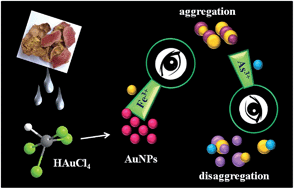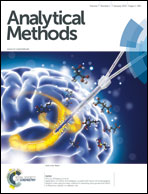Sequential detection of Fe3+ and As3+ ions by naked eye through aggregation and disaggregation of biogenic gold nanoparticles†
Abstract
We have synthesized and stabilized spherical, flower, urchin and polydispersed AuNPs using pomegranate (Punica granatum) peel extract. The AuNPs act as sequential sensors towards Fe3+ as well as As3+ ions. Upon addition of Fe3+ ions, the AuNPs aggregate due to the interaction between the capping agent and Fe3+ ions. The aggregation results in a color change that is visible to the naked eye, which originates from the inter-plasmon coupling of the AuNPs. Interestingly, the AuNP–Fe system disaggregates only in the presence of As3+ ions, resulting in a further color change in the visible region. The aggregation and disaggregation phenomena were examined by UV-vis spectroscopy, DLS, SEM, and TEM. The rates for the aggregation and disaggregation of the AuNP systems in the presence of the metal ions were determined. The naked eye detection limits for Fe3+ and As3+ ions were 10−7 and 10−4 M, respectively. Finally, we have demonstrated the practical application of biosynthesized AuNPs by real sample analysis.


 Please wait while we load your content...
Please wait while we load your content...